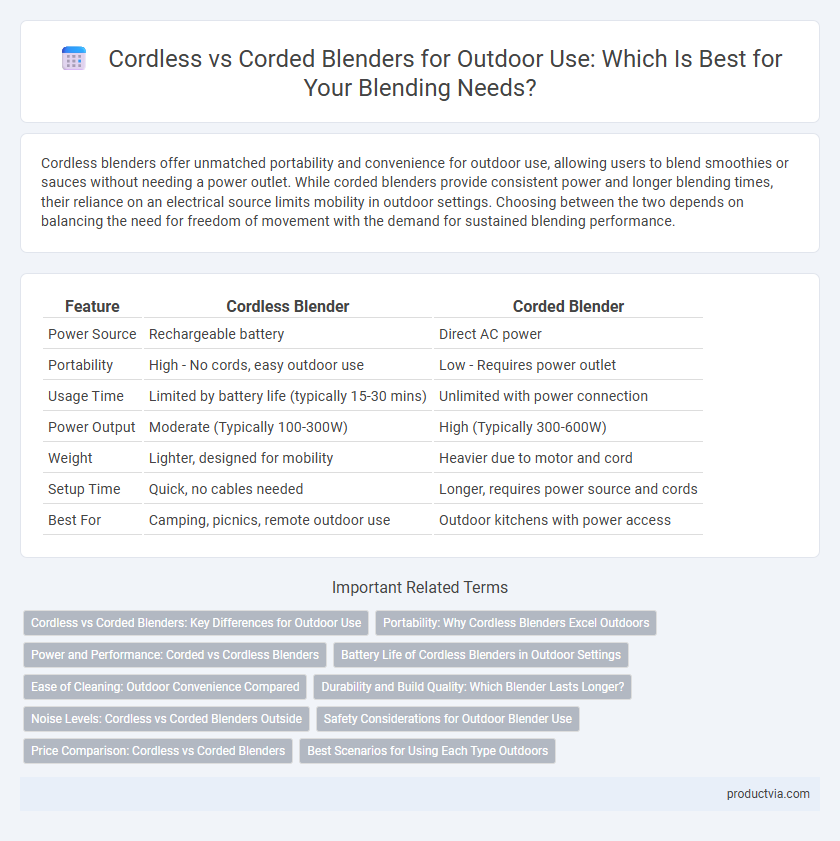Cordless blenders offer unmatched portability and convenience for outdoor use, allowing users to blend smoothies or sauces without needing a power outlet. While corded blenders provide consistent power and longer blending times, their reliance on an electrical source limits mobility in outdoor settings. Choosing between the two depends on balancing the need for freedom of movement with the demand for sustained blending performance.
Table of Comparison
| Feature | Cordless Blender | Corded Blender |
|---|---|---|
| Power Source | Rechargeable battery | Direct AC power |
| Portability | High - No cords, easy outdoor use | Low - Requires power outlet |
| Usage Time | Limited by battery life (typically 15-30 mins) | Unlimited with power connection |
| Power Output | Moderate (Typically 100-300W) | High (Typically 300-600W) |
| Weight | Lighter, designed for mobility | Heavier due to motor and cord |
| Setup Time | Quick, no cables needed | Longer, requires power source and cords |
| Best For | Camping, picnics, remote outdoor use | Outdoor kitchens with power access |
Cordless vs Corded Blenders: Key Differences for Outdoor Use
Cordless blenders offer unparalleled portability and convenience for outdoor use, featuring rechargeable batteries that eliminate the need for power outlets, making them ideal for camping or picnics. Corded blenders, while generally more powerful with consistent electric supply, require access to a power source, limiting their usability in remote or off-grid locations. Battery life, motor strength, and ease of transport are key factors distinguishing cordless from corded blenders in outdoor environments.
Portability: Why Cordless Blenders Excel Outdoors
Cordless blenders excel in outdoor settings due to their high portability, powered by rechargeable lithium-ion batteries that eliminate the need for electrical outlets. Their lightweight design and compact size make them easy to carry on camping trips, picnics, or hiking excursions. Without the restriction of cords, cordless blenders offer flexibility and convenience for blending smoothies, sauces, or baby food anywhere.
Power and Performance: Corded vs Cordless Blenders
Corded blenders typically deliver consistent, high-wattage power ideal for heavy-duty blending tasks, ensuring smooth performance without interruption during extended outdoor use. Cordless blenders offer portability and convenience but may sacrifice some power and blending speed due to battery limitations, making them better suited for light to moderate tasks. Evaluating battery capacity and motor strength is essential when selecting a cordless blender to match the performance standards of corded models for efficient outdoor blending.
Battery Life of Cordless Blenders in Outdoor Settings
Cordless blenders offer the convenience of portability for outdoor use, but their battery life varies widely depending on capacity and usage intensity, typically ranging from 15 to 30 minutes of continuous blending. High-capacity lithium-ion batteries provide longer run times and faster recharging, making some cordless blenders suitable for multiple blending cycles during outdoor activities. Users should consider battery capacity, motor power, and charging options to ensure reliable performance without access to electrical outlets.
Ease of Cleaning: Outdoor Convenience Compared
Cordless blenders offer superior ease of cleaning for outdoor use due to their compact design and the absence of tangled cords, allowing users to quickly rinse and dry components without restricting workspace. Corded blenders, while powerful, can be cumbersome outdoors as cords may attract dirt and debris, complicating the cleaning process and limiting placement options near water sources. Selecting a cordless blender enhances outdoor convenience by streamlining both blending and cleanup, making it ideal for camping, picnics, and other outdoor activities.
Durability and Build Quality: Which Blender Lasts Longer?
Cordless blenders designed for outdoor use often feature robust, impact-resistant materials and sealed components to withstand rough handling and exposure to elements, enhancing durability. Corded blenders typically have heavier, more solid builds with fewer compromises on motor power, but their reliance on power outlets limits versatility and increases wear in outdoor settings. In terms of longevity, cordless blenders with high-quality lithium-ion batteries and reinforced casings generally last longer in outdoor environments due to portability and weather resistance.
Noise Levels: Cordless vs Corded Blenders Outside
Cordless blenders typically produce lower noise levels compared to corded blenders, making them more suitable for outdoor use where minimizing sound disturbance is important. Corded blenders often have more powerful motors that generate louder operational sounds, which can be disruptive in quiet outdoor environments. Battery-powered cordless blenders provide a quieter blending experience, enhancing the enjoyment of outdoor activities like picnics or camping.
Safety Considerations for Outdoor Blender Use
Cordless blenders offer enhanced safety for outdoor use by eliminating the risk of tripping over power cords and potential electrical hazards in wet or uneven environments. Corded blenders require reliable access to power outlets and careful management of cords to prevent accidents, especially near water or in rugged terrain. Prioritizing battery-operated models with sealed, splash-resistant designs reduces the likelihood of electrical shocks and ensures safer blending in outdoor settings.
Price Comparison: Cordless vs Corded Blenders
Cordless blenders generally have a higher upfront cost due to built-in rechargeable batteries and portability features, often ranging from $50 to $150. Corded blenders tend to be more affordable, with prices typically between $30 and $80, but require a power source, limiting outdoor usability. Price differences reflect the convenience and mobility that cordless models offer for outdoor blending tasks.
Best Scenarios for Using Each Type Outdoors
Cordless blenders offer unmatched portability and convenience for outdoor use, making them ideal for camping, picnics, and tailgating where power outlets are unavailable. Corded blenders, while less portable, provide constant and reliable power, making them perfect for outdoor kitchens or events with accessible electrical sources. Choosing between the two depends on the availability of power and the desired blending duration during outdoor activities.
Cordless blender vs corded blender for outdoor use Infographic

 productvia.com
productvia.com